Transform your windows into stunning green showcases with the timeless art of hanging plants. We’ve discovered that positioning plants in front of windows creates an enchanting living curtain that filters natural light while bringing vibrant life to any room.
Window-hung plants aren’t just decorative elements – they’re natural air purifiers that thrive in bright, indirect sunlight. Whether you’re working with a small apartment or spacious home, we’ll show you how this simple design choice maximizes your growing space while creating Instagram-worthy plant displays.
The magic happens when sunlight dances through cascading foliage, casting beautiful shadows and creating depth in your living space. From trailing pothos to flowering begonias, we’ve tested countless varieties to bring you foolproof techniques that’ll turn your windows into green sanctuaries that neighbors will envy.
Choose the Right Window for Your Hanging Plants
Selecting the perfect window location determines your hanging plants’ success and longevity. We’ll explore three crucial factors that influence plant health and growth when positioning your green displays.
Consider Light Direction and Intensity
South-facing windows provide the most intense light throughout the day, making them ideal for sun-loving plants like succulents and cacti. We recommend placing light-sensitive plants like pothos and snake plants at least 3-4 feet away from these high-intensity windows to prevent leaf burn.
East-facing windows offer gentle morning sunlight that gradually increases, perfect for most flowering plants such as begonias and impatiens. These locations receive approximately 4-6 hours of direct sunlight daily, creating optimal conditions for moderate light plants.
West-facing windows deliver strong afternoon sun that can be harsh for delicate foliage. We suggest using these spots for hardy plants like rubber trees and fiddle leaf figs, or installing sheer curtains to filter the intense afternoon rays.
North-facing windows provide consistent, indirect light ideal for low-light plants including philodendrons and ZZ plants. These locations work exceptionally well for creating lush, green displays without worrying about sun damage.
Evaluate Window Size and Space
Large windows (6 feet or wider) accommodate multiple hanging plants at varying heights, creating stunning layered displays. We can arrange 3-5 plants using macrame hangers, ceiling hooks, and wall-mounted brackets to maximize the visual impact.
Standard windows (3-4 feet wide) work best with 1-2 strategically placed plants that won’t overwhelm the space. Single statement plants like large Boston ferns or trailing ivy create elegant focal points without cluttering the view.
Small windows (under 3 feet) require careful plant selection to avoid blocking natural light. We recommend using compact varieties such as small air plants or single trailing pothos that enhance rather than obstruct the window opening.
Window depth affects hanging plant placement, with deeper sills providing more positioning options. Windows with 6-inch or greater depth allow plants to hang closer to the glass while maintaining proper air circulation.
Assess Temperature Fluctuations
Seasonal temperature changes near windows can stress hanging plants, especially during winter months when glass surfaces become cold. We monitor temperatures that drop below 60°F, which can damage tropical plants like monstera and prayer plants.
Daily temperature swings of more than 15°F between day and night can shock sensitive plants. Windows facing extreme weather conditions require extra attention, particularly during summer heat waves or winter cold snaps.
Heating and cooling vents positioned near windows create unstable temperature zones that affect plant health. We keep hanging plants at least 3 feet away from HVAC vents to prevent rapid temperature changes and excessive air circulation.
Insulation quality of windows impacts the temperature stability around your hanging plants. Single-pane windows create more extreme temperature fluctuations compared to double-pane alternatives, requiring more careful plant selection and positioning.
Select the Perfect Plants for Window Hanging
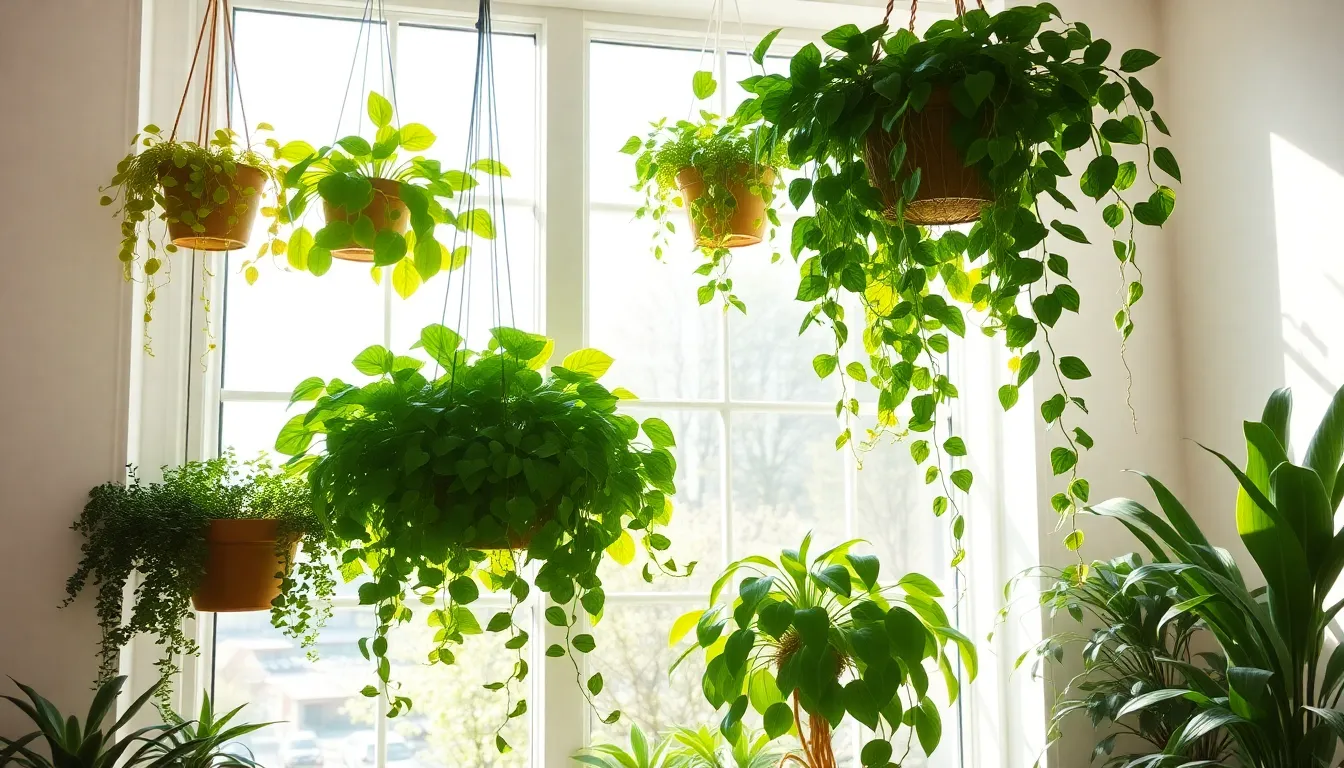
We recommend choosing plants based on their light requirements and natural growth habits for the best results. Trailing plants with cascading stems create stunning hanging displays that maximize your window’s potential.
Low-Light Tolerant Varieties for North-Facing Windows
ZZ Plant (Zamioculcas zamiifolia) stands out as our top choice for north-facing windows due to its exceptional adaptability to low light conditions. This slow-growing beauty requires minimal watering and thrives best when positioned near the window without being placed too far into the room.
English Ivy offers classic elegance with its trailing vines that tolerate lower light beautifully. We love how it creates natural cascading curtains that add sophistication to any space.
Heartleaf Philodendron provides lush green foliage that trails gracefully in shadier conditions. Its heart-shaped leaves create an attractive display even in minimal lighting.
Spider Plant develops stunning arching leaves with baby plantlets that dangle like natural ornaments. We find it performs exceptionally well in indirect light near north-facing windows.
Boston Fern brings a touch of wilderness indoors with its feathery fronds that prefer shadier spots. Position it close enough to the window to receive some brightness while avoiding direct exposure.
Sun-Loving Plants for South-Facing Windows
Trailing Succulents excel in bright, direct sunlight that south-facing windows provide. We recommend varieties like String of Pearls or Burro’s Tail that create unique cascading effects.
Sun-Tolerant Vines thrive in full sun conditions and develop robust growth patterns. These plants handle intense afternoon light without showing stress signs.
Edible Hanging Plants require full sunlight exposure to produce healthy harvests. We suggest hanging herb gardens or cherry tomato varieties that benefit from maximum light exposure.
Heat-Loving Varieties adapt well to the warmer temperatures that south-facing windows generate. Position these plants where they’ll receive direct morning and afternoon sun for optimal growth.
Best Plants for East and West Window Exposures
Devil’s Ivy (Pothos) adapts perfectly to moderate sunlight conditions found in east and west exposures. We appreciate how it tolerates some direct light while preferring bright indirect conditions for most of the day.
Moderate Light Trailing Plants flourish in the balanced lighting that morning or afternoon sun provides. These versatile options work well when positioned to receive indirect light during peak hours.
Adaptable Cascading Varieties handle the changing light patterns that east and west windows experience throughout the day. We recommend selecting plants that can adjust to both morning brightness and afternoon intensity.
Flowering Hanging Plants particularly benefit from east-facing morning sun that’s gentle yet energizing. Position these beauties where they’ll catch the soft morning rays while avoiding harsh afternoon heat.
Install Proper Hanging Hardware for Window Plants
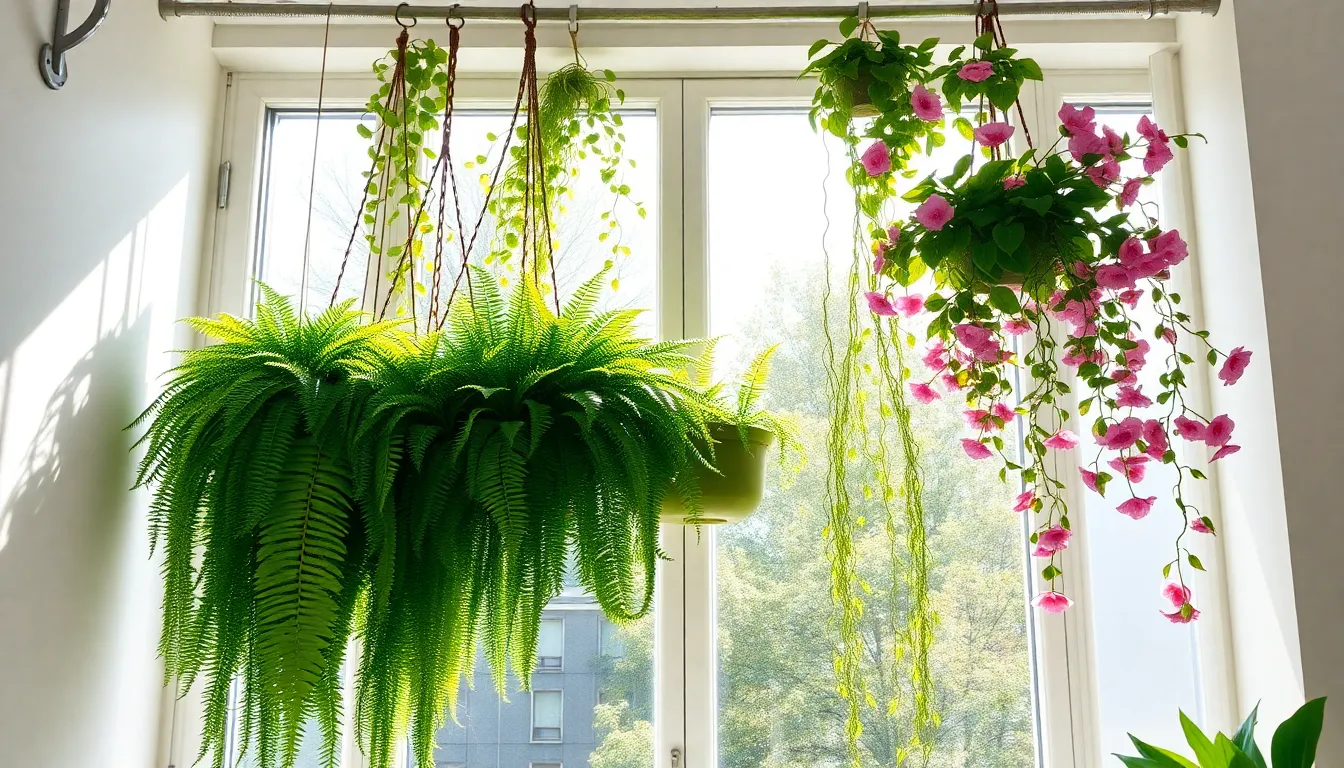
Proper hardware installation ensures your window plants stay secure while creating stunning displays. We’ll explore three reliable mounting methods that accommodate different weight requirements and installation preferences.
Ceiling Mount Options and Weight Capacity
Screw-in ceiling hooks provide the strongest support for heavier plants, with some models holding up to 50 pounds. Toggle bolts with swag hooks work best for drywall ceilings, expanding behind the surface to distribute weight evenly across a larger area.
Locating ceiling joists gives you maximum holding power when you screw hooks directly into solid wood. Use a stud finder to identify joist locations, ensuring your heaviest cascading plants won’t fall unexpectedly.
Testing hook strength before hanging plants prevents accidents and gives you confidence in your installation. Pull down firmly on each hook to verify it can handle your plant’s weight plus water and soil.
Wall Bracket Systems for Side Mounting
Wall brackets mounted on either side of your window frame create a versatile rod system for multiple plants. Measure your window width accurately to cut the dowel to the proper length, allowing it to rest securely on both brackets.
Adjustable plant placement becomes possible when you install a rod system, letting you slide hangers along the dowel for optimal spacing. This flexibility helps you arrange plants of different sizes without overcrowding your window display.
Weight distribution spreads evenly across the rod system, making it suitable for medium weight plants that might strain a single ceiling hook. Position brackets at the same height on both sides for a professional, balanced appearance.
Tension Rod Answers for Temporary Displays
Tension rods fit inside window frames without drilling, making them perfect for renters or temporary plant displays. These spring loaded rods press against the window frame to stay in place without causing damage.
Lightweight plants work best with tension rod systems since they have limited weight capacity compared to permanent mounting options. Small potted plants in mesh shopping bags hook easily over tension rods for instant hanging gardens.
Easy removal makes tension rods ideal for seasonal plant rotations or apartment living where permanent installations aren’t allowed. Simply twist the rod to release tension and remove without leaving marks or holes in your window frame.
Position Your Hanging Plants for Optimal Growth
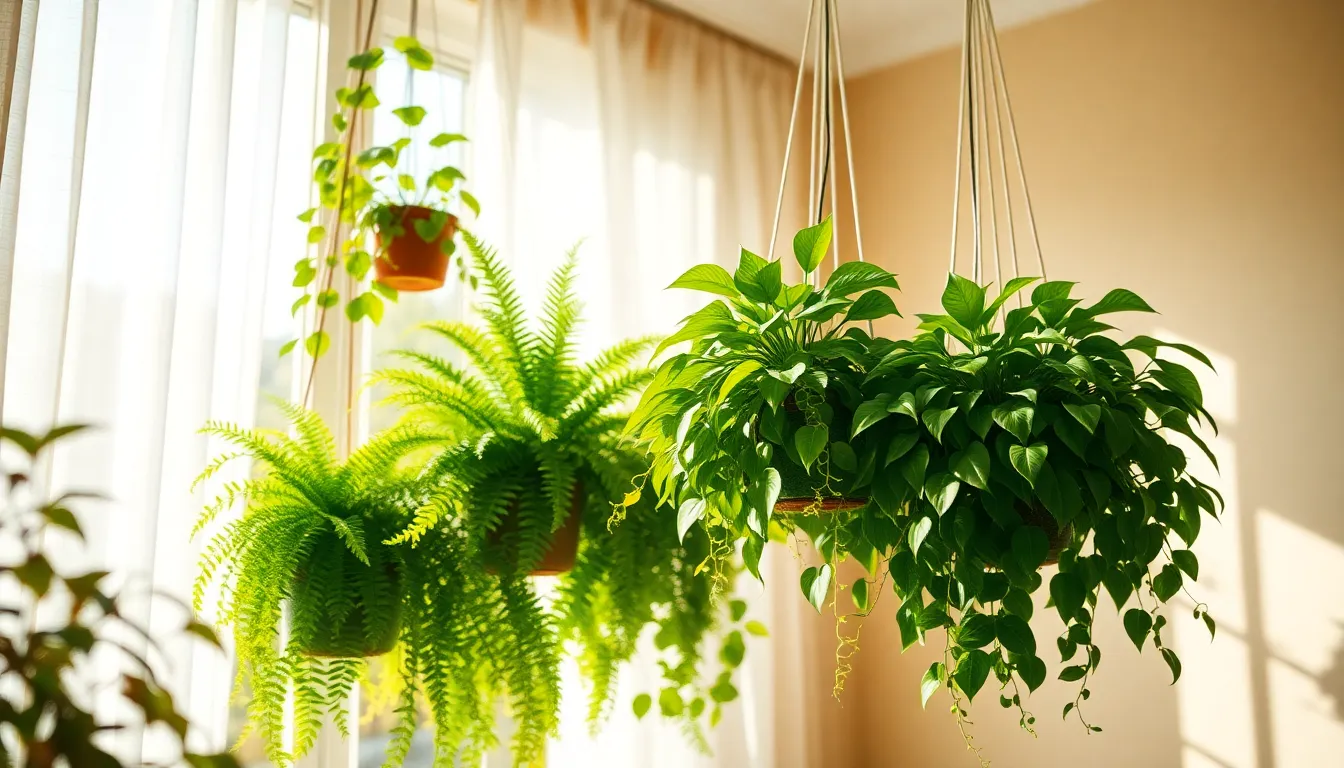
Now that we’ve selected the perfect plants and installed secure hardware, we need to focus on strategic positioning to maximize their health and visual impact.
Maintain Adequate Distance from Glass
Keeping our plants slightly away from window glass protects them from temperature extremes and light damage. Direct contact with glass can cause leaf burn from intense sunlight or shock from cold drafts during winter months. We recommend positioning hanging plants at least 6-12 inches away from the window surface to create a protective buffer zone.
Window temperature fluctuations pose a important threat to plant health throughout the year. During summer months, glass surfaces can become extremely hot and radiate heat that stresses our plants. Winter brings the opposite challenge as cold glass can create microclimates that damage sensitive foliage.
Using sheer curtains or blinds helps us diffuse harsh sunlight while still providing adequate illumination. These window coverings act as natural filters that protect our plants from the most intense rays while maintaining the bright conditions they need to thrive.
Create Layered Heights for Visual Appeal
Hanging plants at varying heights transforms a simple window display into a ever-changing living artwork. We can achieve this layered effect by using adjustable chain systems, macrame hangers of different lengths, or tiered bracket installations that create natural steps.
The key to successful layering lies in combining plants with different growth habits and sizes. Tall, dramatic plants like Boston ferns work beautifully as anchor points, while smaller trailing varieties such as pothos can fill in the middle and lower levels. This approach creates depth and visual interest that draws the eye naturally through the entire display.
Adjustable hanging systems offer the flexibility we need for both aesthetics and maintenance. We can easily lower plants for watering and pruning, then readjust their heights to maintain our desired visual composition. This practical approach ensures our layered display remains both beautiful and manageable over time.
Ensure Proper Air Circulation Around Plants
Good airflow prevents the moisture related problems that commonly plague indoor hanging plants. Stagnant air creates perfect conditions for mold, mildew, and pest infestations that can quickly damage or destroy our carefully curated displays. We need to maintain adequate spacing between plants to allow natural air movement.
Overcrowding our window plants blocks the circulation they need to stay healthy. Each plant should have enough space around its foliage for air to move freely, typically requiring 12-18 inches between larger specimens and 6-8 inches between smaller varieties.
Ceiling fans set on low speed can supplement natural air movement without creating harmful drafts. We should avoid placing plants directly under air conditioning vents or heating registers, as these create uneven air patterns that stress plants and disrupt their growth patterns.
Master Watering Techniques for Window-Hung Plants
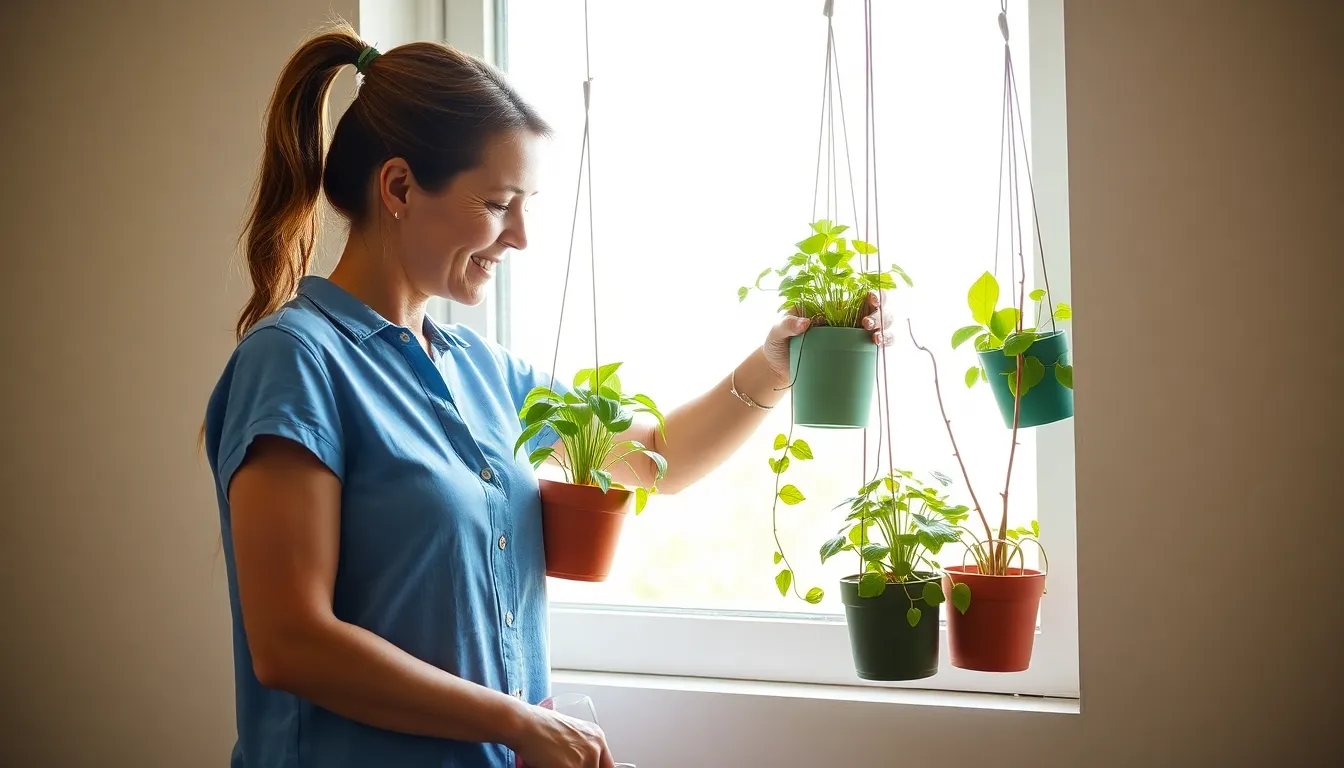
Watering hanging plants near windows requires special techniques to avoid mess while ensuring proper hydration. We’ll share proven methods that protect your home while keeping plants thriving.
Prevent Water Damage to Window Frames
Water damage poses a serious threat to window frames when caring for hanging plants. We recommend using drip trays or saucers under every plant pot to catch excess water before it reaches your window sill or frame.
Removing plants from their hanging position before watering eliminates splashing risks entirely. Take each plant to your kitchen sink for thorough watering, then allow complete drainage before returning it to the window area.
Over-watering increases the likelihood of water seepage around windows, so we suggest monitoring soil moisture levels carefully. Avoid watering until the top inch of soil feels dry to prevent unnecessary water accumulation near sensitive window materials.
Use Drip Trays and Saucers Effectively
Proper drip tray selection makes all the difference in protecting your window area. We choose trays with raised edges that can securely hold excess water and prevent overflow onto surrounding surfaces.
Water-resistant materials like plastic or ceramic work best for catching drainage water without deteriorating over time. Size your trays appropriately to accommodate the full diameter of each hanging basket plus any potential water spread.
Regular monitoring prevents standing water from accumulating in trays, which can cause root rot or attract unwanted pests. Empty collected water within 24 hours to maintain healthy growing conditions and protect your window frame from prolonged moisture exposure.
Adjust Watering Schedule Based on Light Exposure
Window placement dramatically affects how often we need to water hanging plants. Plants receiving high light levels near windows experience increased evaporation and require more frequent hydration than those in lower light conditions.
Morning watering between 5 am and 9 am works best for plants exposed to direct sunlight, ensuring roots stay moist throughout the day’s heat. We water thoroughly using about 1 gallon for 12-14 inch baskets during peak growing season.
Temperature fluctuations between 25°C and 40°C may require watering once or twice daily during hot seasons. Cooler periods allow us to reduce frequency to every few days, adjusting based on soil moisture levels rather than following rigid schedules.
Small portion watering with pauses between applications prevents runoff while allowing soil to absorb moisture effectively. We can also use 2-4 ice cubes placed on soil surfaces for slow, steady hydration without shocking plant roots, ensuring cubes don’t touch stems directly.
Style Your Window Plant Display for Maximum Impact
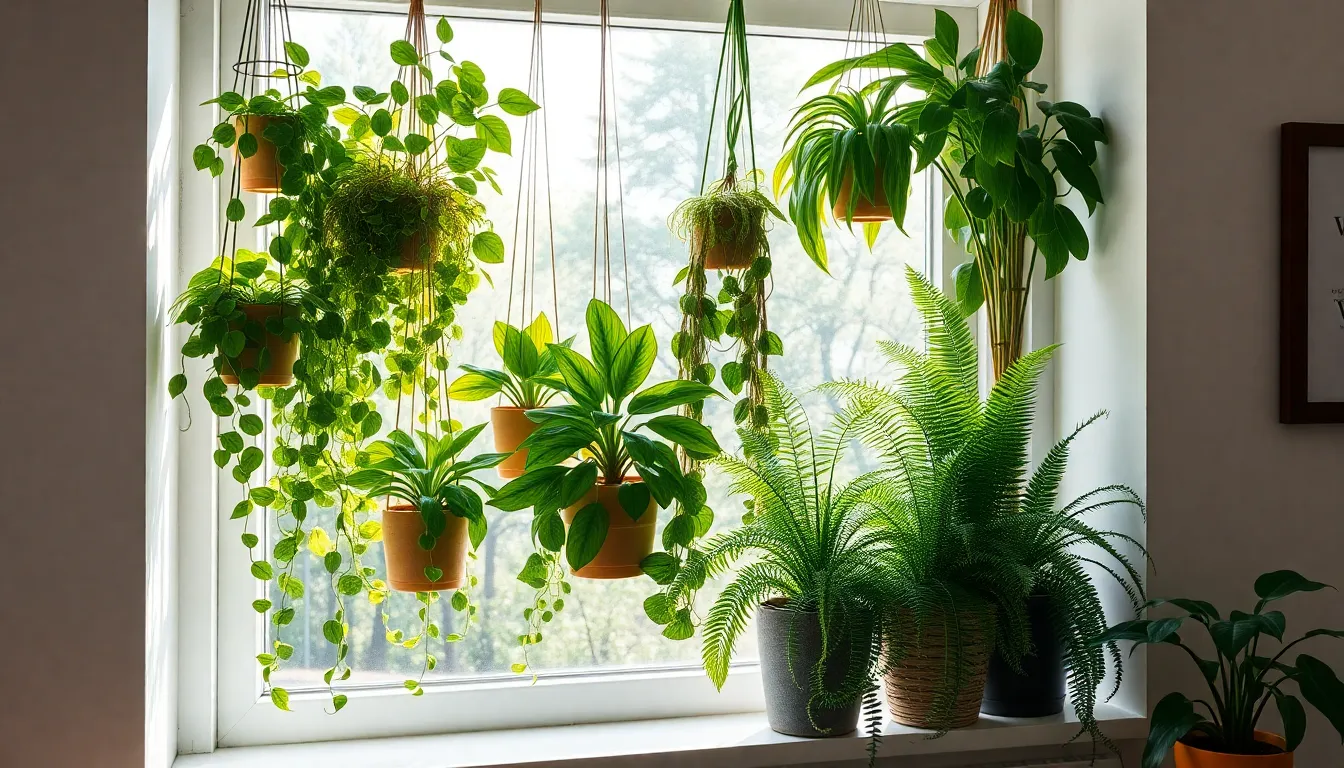
Creating a stunning window plant display requires thoughtful arrangement and design choices that maximize both visual appeal and plant health.
Mix Plant Sizes and Textures
Combining plants of varying heights creates ever-changing visual interest that draws the eye naturally across your display. We recommend pairing trailing plants like pothos or string of pearls with bushier varieties such as ferns or spider plants to add depth and dimension to your arrangement.
Contrasting leaf shapes and textures enhances the overall aesthetic appeal of your window garden. Small-leafed plants like baby tears work beautifully alongside broad-leafed varieties such as monstera delicately or heartleaf philodendrons.
Layering different growth patterns helps create a natural, garden-like appearance even in indoor spaces. Fast-growing vines can cascade down while compact plants fill middle spaces and tall, upright varieties anchor the display from above.
Coordinate Planters with Your Decor
Choosing planters that complement your room’s style ensures your hanging garden integrates seamlessly with your existing decor. Sleek modern pots work perfectly in contemporary spaces while rustic baskets or macrame hangers enhance bohemian or farmhouse aesthetics.
Color coordination strategies can either help your planters blend harmoniously with window frames or create striking focal points. Neutral tones like white, cream, or natural wood typically complement most interior color schemes without overwhelming the space.
Material selection impacts both appearance and plant health considerations. Terra cotta pots provide excellent drainage and breathability while ceramic planters offer more color options and water retention for moisture-loving plants.
Create Seasonal Displays with Rotating Plants
Rotating plants seasonally keeps your display fresh and protects sensitive varieties from harsh weather changes near windows. Spring displays might feature blooming plants like begonias or impatiens while winter arrangements could showcase hardy succulents or evergreen varieties.
Seasonal transitions allow you to showcase different plant characteristics throughout the year. Summer displays can highlight heat-tolerant trailing plants while autumn arrangements might feature plants with colorful foliage like coleus or caladiums.
Strategic plant rotation also extends the lifespan of your collection by moving plants to optimal growing conditions based on seasonal light changes and temperature fluctuations near windows.
Maintain Healthy Hanging Plants in Front of Windows
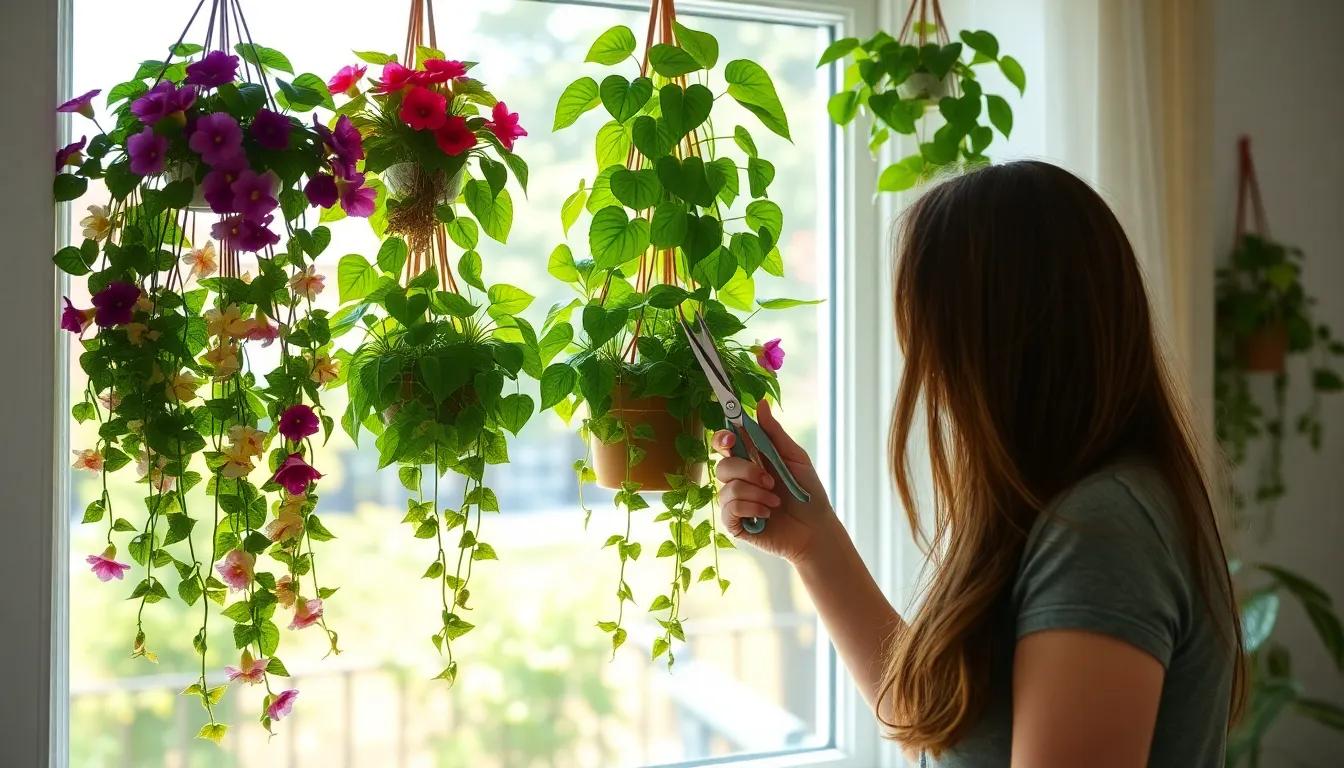
Now that we’ve positioned our hanging plants perfectly, we’ll need to establish consistent care routines to keep them thriving in their window environments. Window locations create unique growing conditions that require exact maintenance approaches.
Regular Pruning and Deadheading Practices
Pruning encourages bushier and fuller growth in window hanging plants. We should pinch back long trailing stems regularly to prevent our plants from becoming sparse or leggy. Removing dead or yellowing leaves frequently maintains both health and visual appeal for our window displays.
Deadheading spent flowers promotes new blooms throughout the growing season. We can simply pinch off faded blossoms at their base to redirect the plant’s energy toward fresh growth. This practice keeps our flowering varieties like trailing petunias and begonias producing colorful displays.
Weekly inspection of our hanging plants allows us to identify areas needing attention. We should focus on removing any damaged stems or leaves that could harbor pests or diseases. Regular maintenance prevents small issues from becoming major problems in our window garden collections.
Monitor for Pests and Diseases
Early detection allows prompt treatment before pests spread throughout our hanging plant collection. We need to inspect both the upper and lower surfaces of leaves for signs of spider mites, aphids, or scale insects. Window environments can create ideal conditions for certain pests due to consistent warmth and humidity.
Regular inspection should include checking for yellowing leaves, sticky honeydew, or small webs between stems. We can catch most pest problems by examining our plants during routine watering sessions. Quick action prevents infestations from damaging multiple plants in our window displays.
Maintaining good airflow around hanging plants reduces disease risks significantly. We should ensure adequate spacing between plants to prevent moisture buildup that encourages fungal growth. Avoiding overwatering also lowers the chances of root rot and other moisture related diseases.
Rotate Plants for Even Growth Patterns
Rotating plants periodically ensures all sides receive equal light exposure from our windows. We should turn each hanging plant a quarter turn every week to prevent uneven growth patterns like leaning or one sided foliage development. This simple practice results in healthier, well shaped plants.
Window light typically comes from one direction, causing plants to grow toward the light source naturally. We can counteract this tendency by consistently rotating our hanging containers during routine care sessions. Even growth creates more attractive displays and stronger plant structures.
Plants that remain stationary develop weak stems on their shaded sides over time. We’ll notice improved plant symmetry and fuller foliage when we maintain regular rotation schedules. This practice becomes especially important for trailing varieties that need balanced growth along all their cascading stems.
Troubleshoot Common Issues with Window Hanging Plants
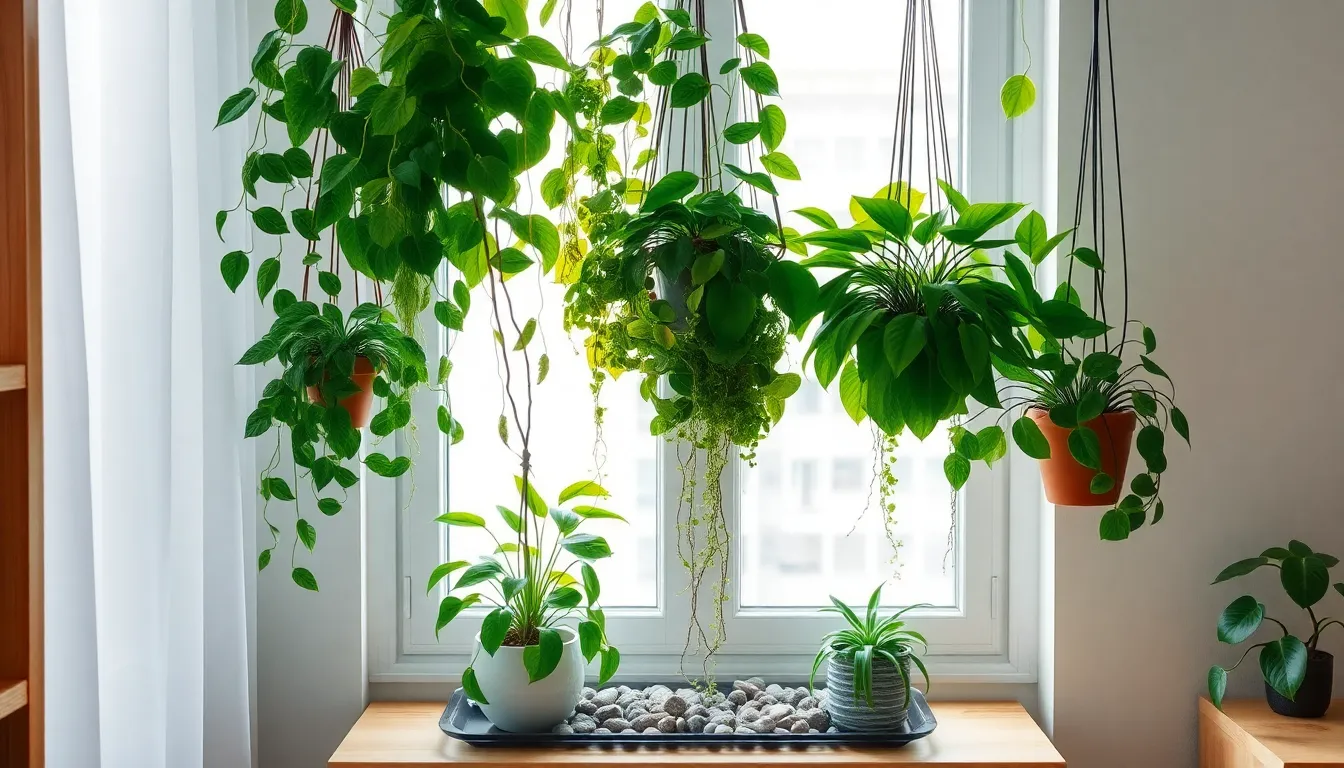
Window placement presents unique challenges that we’ll address with targeted answers to keep your hanging plants thriving throughout the seasons.
Address Leggy Growth from Insufficient Light
Leggy growth signals your hanging plants aren’t receiving adequate light exposure, causing them to stretch desperately toward available brightness. Plants develop long, thin stems with sparse foliage when positioned too far from their light source or in consistently dim conditions. Moving your containers closer to windows immediately improves their access to bright indirect light.
Selecting shade tolerant varieties prevents this issue from developing in naturally darker spaces. Pothos, spider plants, and air plants adapt well to lower light conditions while maintaining compact, attractive growth patterns. Rotating your plants weekly ensures all sides receive equal light distribution and promotes balanced development.
Positioning plants within three feet of east or west facing windows maximizes their light intake without causing sun damage. Deep shade locations consistently produce weak, stretched stems that compromise your plant’s overall health and visual appeal.
Prevent Heat Stress from Direct Sun Exposure
Direct sunlight through glass creates intense heat that burns delicate leaves and causes important plant stress. Scorched edges and crispy foliage indicate your hanging plants are receiving too much concentrated sunlight through windows. Filtering harsh rays protects sensitive varieties while still providing necessary illumination for healthy growth.
Positioning plants several feet away from windows reduces heat intensity while maintaining adequate brightness levels. Sheer curtains create perfect diffused lighting conditions that prevent leaf burn without blocking essential light wavelengths. East facing windows provide gentle morning sun that energizes plants without afternoon heat stress.
West facing exposures require extra protection during peak afternoon hours when sunlight becomes most intense. Using adjustable blinds allows you to control light levels throughout the day based on seasonal changes and weather conditions.
Temperature fluctuations near glass surfaces stress hanging plants, especially during extreme weather periods. Maintaining consistent distances from window panes prevents rapid temperature changes that shock root systems and damage foliage.
Manage Humidity Levels Near Windows
Humidity management becomes critical near windows where air circulation and temperature changes affect moisture levels around your hanging plants. Dry air from heating systems during winter months causes leaf browning and stunted growth in humidity loving varieties. Creating localized humidity zones supports plant health in challenging window environments.
Grouping multiple hanging plants together generates beneficial microclimates with higher moisture content through natural transpiration processes. Misting plants regularly adds necessary humidity, though we recommend doing this early in the day to prevent fungal issues. Humidity trays filled with pebbles and water provide consistent moisture without creating soggy soil conditions.
Drafts from poorly sealed windows stress plants by creating rapid humidity and temperature changes. Positioning containers away from direct airflow prevents shock while maintaining good air circulation around foliage. Double paned windows reduce temperature fluctuations that affect humidity levels near your hanging displays.
Winter heating systems create particularly dry conditions that require additional humidity support through strategic plant placement and supplemental moisture techniques.
Conclusion
Transforming your windows into living green sanctuaries with hanging plants creates a stunning focal point that benefits both your home’s aesthetics and air quality. We’ve covered everything from selecting the perfect plants for your window’s light conditions to mastering installation techniques and ongoing care routines.
Remember that success lies in matching your plant choices to your exact window conditions and maintaining consistent care practices. With proper hardware installation strategic positioning and regular maintenance your hanging garden will thrive year-round.
Start small with one or two easy-care varieties and gradually expand your collection as you gain confidence. Your patience and attention to detail will reward you with a breathtaking display that brings nature’s beauty directly into your living space while creating a peaceful green oasis you’ll enjoy for years to come.
Frequently Asked Questions
What are the benefits of hanging plants in front of windows?
Hanging plants in windows serve as natural air purifiers while creating beautiful living curtains. They thrive in bright, indirect sunlight and transform ordinary windows into captivating displays. These plants maximize growing space in any home size and create an enchanting effect as sunlight filters through their foliage.
Which window direction is best for hanging plants?
South-facing windows are ideal for sun-loving plants, east-facing windows suit flowering varieties that prefer gentle morning light, and north-facing windows work best for low-light tolerant plants. The direction determines light intensity and duration, which directly impacts plant health and growth patterns.
What are the best low-light hanging plants for north-facing windows?
ZZ Plant, English Ivy, Heartleaf Philodendron, Spider Plant, and Boston Fern are excellent choices for north-facing windows. These varieties tolerate lower light conditions and maintain healthy growth without direct sunlight, making them perfect for darker window exposures.
How do I properly install hanging hardware for window plants?
Use screw-in ceiling hooks for heavier plants, wall bracket systems for versatile side mounting, or tension rods for temporary displays. Consider weight capacity and ensure secure installation. Position hardware to maintain 6-12 inches distance from window glass for optimal plant health.
How should I water hanging plants near windows?
Use drip trays to protect window frames and remove plants before watering to avoid splashing. Water only when the top inch of soil feels dry. Morning watering works best for plants in direct sunlight, and consider using ice cubes for slow, steady hydration.
How can I prevent heat stress in window hanging plants?
Use sheer curtains or blinds to diffuse harsh direct sunlight while maintaining adequate illumination. Maintain proper distance from window glass and ensure good airflow between plants. Monitor for signs of heat stress like wilting or leaf scorch and adjust positioning accordingly.
What’s the best way to style multiple hanging plants in windows?
Mix different plant sizes and textures for visual interest, coordinate planters with room decor, and create layered heights using adjustable hanging systems. Maintain adequate spacing between plants for proper airflow and consider seasonal rotation to keep displays fresh and protect sensitive varieties.
How often should I inspect and maintain my window hanging plants?
Perform weekly inspections to identify pest or disease issues early. Regular pruning and deadheading encourage fuller growth and new blooms. Rotate plants periodically for even growth patterns and maintain consistent care routines including proper spacing and airflow management.







